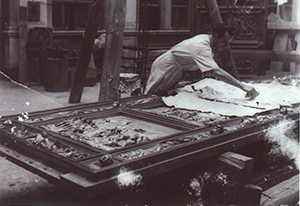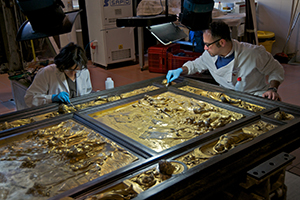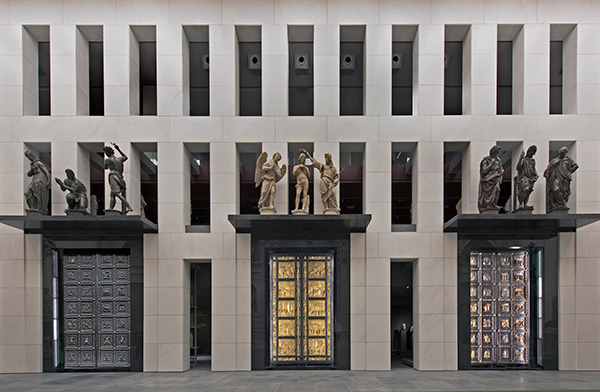CONTEMPORARY CASTS
Originally installed in the eastern portal of the Florence Baptistery in 1452, the Gates of Paradise weathered a number of storms among other catastrophes: war, a torrential flood, vandalism, overzealous polishing, and air pollution.The idea of producing casts as a way to preserve the original doors was born in the aftermath of World War II. In 1943, the Gates of Paradise and other important works of Italian art were hidden to protect them from Allied attacks. These treasures, which included the Gates of Paradise, returned to public view after the war.
From 1946 to 1948, the doors underwent restoration. A Florentine foundry owner, Bruno Bearzi, performed rudimentary conservation on the panels of the Gates of Paradise, which had lost their original luster and accumulated soot and grime. At that time, Bearzi also created meticulous plaster molds of the doors directly from Ghiberti's original work. The casts displayed at the Nelson-Atkins Museum of Art, and the sister set currently installed in the east portal of the Florence Baptistery, both derive from Bearzi's molds.

Bruno Bearzi executing plaster molds on the original Gates of Paradise by Lorenzo Ghiberti, after having restored them. Florence, 1947
The Gates of Paradise casts at the Nelson-Atkins were produced in 1990 through a combination of lost-wax casting and 3D technology by the Frilli Gallery, Florence. The casting, gilding, chasing, and installation processes were similar to those performed later, in the 2000s, for the new casts of Ghiberti's north doors of the Baptistery, as demonstrated here.
Despite Bearzi's restoration efforts in the late 1940s, the doors continued to sustain damage. Just a few months after the Gates of Paradise were reinstalled at the Baptistery in 1948, the panels suffered from residues of copper salts, lead, and caustic soda that had not been removed during Bearzi's cleaning. Furthermore, atmospheric pollution, from coal and oil heating systems and vehicle exhaust, was increasing. It formed a dark, grimy film on the surface of the doors.
Various restoration campaigns continued, along with evolving research in the field of conservation science. These efforts revealed an insidious problem. Fluctuations in humidity had caused oxides on the bronze beneath the gilding to dissolve and recrystallize, triggering a reaction that produced tiny craters and blisters on the gold surface. These discoveries formed the basis for the most recent campaign to restore the Gates of Paradise. As part of this effort, the doors were permanently removed from the Baptistery in 1990 and replaced with contemporary casts.

Conservators perform a treatment on the original Gates of Paradise in Florence. Firenze magazine.

At center, the original Gates of Paradise on view at the Museo dell'Opera del Duomo in Florence. Ghiberti's earlier north doors are also on view, to the right. Opera di S. Maria del Fiore, Firenze